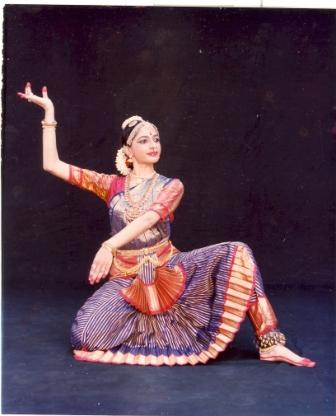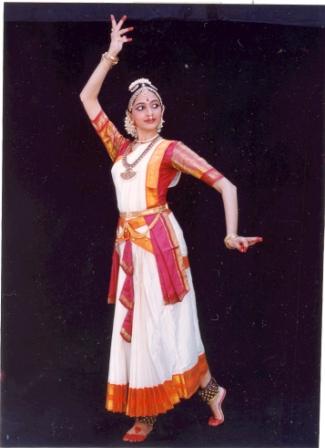Contribute
| Bharatanatyam And Carnatic Music At Harvard |
Ranjani Saigal
03/19/2008
Classic, precise and clean movements marked Sunanda Narayanan’s presentation at the Agassiz theater at Harvard University, where she presented a lecture-demonstration on Bharatanatyam under the auspices of the South Asia initiative at Harvard University on March 14, 2008.
The event opened with a welcome by Rena Fonseca, Asst. Director of the South Asian initiative at Harvard. Sunanda’s presentation followed. She opened with Todaya Mangalam, an invocation to the Gods of the temple of Vazhavoor village. She then proceeded to describe the various aspects of the art form of Bharatanatayam.
Vande Mataram a unique piece choreographed by Guru Radha where Bankimchandra Chattopadhyay’s original lyrics are enmeshed with Subramania Bharati’s Vande Matarm along with Swarams and Jathi patters from Allaripu was presented as a Pushpanjali – a flower offering to Mother India. Every movement fit perfectly to describe the grandeur and beauty of mother India and quite a tribute to the choreographic genius of her Guru.
She then presented the classic Kamas Varnam “Samiyai Azhaithu Vaa Sakhi†which is a translation of the Telugu Varnam “Sami Nee Ram Maenave†written by the Tanjore Quartet. Nice Sancharis, interesting Jathis made for a nice traditional piece that reached out to the audience.
In the second half Sunanda presented the cute Javali “Nee Matale Maayunara†where the heroine admonishes her lover for not buying her all the presents he had promised. Next the famous Bharatiyar composition “Chinanan chiru Kiliye†where the poet speaks of the joy of being with a child was presented. The lyrics in the typical Bharatiyar style are powerful and tug strongly at the emotional strings.
She then moved on to a contemporary work “Maram†with words by Vairamuthu set to tune by her illustrious mother, Smt Sujatha Vijayaraghavan. The poet is entranced by the beauty of trees that he calls Nature's paintings and revels in seeing their branches that seem to stretch skywards to ensnare the stars, the leaves that laugh and whisper with the wind, and the many flowering blooms. "You stand like an exclamation mark on this earth", he says lost in the wonder that is the tree. The verses of the poem outline the many virtues of trees and their selflessness in giving of themselves, be it to bird, beast, or us human beings. The poet laments through a clever play with words, the mindlessness of human beings when they cut trees down paying no heed to the consequences. "Come to the tree and listen to its message", he pleads of fellow humans.
The performance ended with a Tillana & Mangalam. The Tillana performed was a composition of violin maestro Lalgudi Jayaraman in ragam Tilang and Adi Talam. A short verse at the end is addressed to the Muruga, a South Indian deity who with his peacock for a vehicle is considered the very embodiment of beauty. This was followed by the final item - "Naadavindu Kalaadi", also in praise of Lord Muruga served as the Mangalam.
During the intermission, Samir Rao a senior at Harvard university presented a short but moving musical interlude. He was accompanied by Ameya Velingker (Harvard, Class of 2010) on the harmonium and Anandh Swaminathan (MIT, Class of 2011). The pieces he picked Kannan Endradume (Ragamalika), Saramaina (Behag), Venkatachala Nilayam (Sindhubhairavi) are known for their emotional appeal and Samir did a fine job not only with the melody and talam but also with Bhava. The accompanists also did an excellent job. It is always a pleasure to see youngsters with such a passion for classical music.
You may also access this article through our web-site http://www.lokvani.com/

